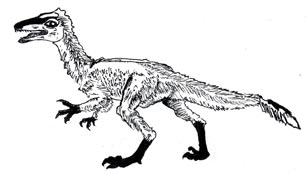New Dinosaur Species from North-western China
New Meat-Eating Dinosaur from China
Fossils uncovered in 2006 by a team of international researchers as they explored a remote part of Xinjiang Province have been identified as a new species of predatory theropod dinosaur. This new, meat-eating dinosaur discovery has been tentatively ascribed to the Coelurosauria. Although this is the seventh theropod and the fourth coelurosaur discovered in strata from the Shishugou Formation, it represents the earliest fossil coelurosaur discovered from this Formation to date.
New Dinosaur Species
Fossils of small dinosaurs are exceptionally rare, those specimens known from the Middle Jurassic tend to consist of isolated fragments of bone, or individual teeth. Although far from complete, the fossil material represents an individual animal and it consists of the skull and mandible, limb bones, vertebrae, digits and elements from the pelvic girdle. The three previously discovered coelurosaurs from the same Chinese location (Guanlong, Haplocheirus and Zuolong) were found at higher stratigraphical layers, thus indicating that this new discovery is much older than those previously found.
It is thought that this new discovery dates from approximately 161 million years ago, (Callovian faunal stage). This would suggest that this little carnivore roamed China during the Middle Jurassic, however, this specimen could also be referred to as Late Jurassic as the radiometric dates for the strata from which the fossil was excavated, fall within the margin of error delineating the geological boundary between the Middle and Late Jurassic.
The Skull of Aorun zhaio
Picture credit: James Clark/George Washington University
The picture above shows the skull with a coin providing scale.
Aorun zhaio
The new species has been named Aorun zhaio (The Dragon King of the West), from “Ao Run” taken from the Mandarin Chinese language and the Chinese epic folklore tale, “Journey to the West”. The species name honours Professor Zhao Xi-jin, a renowned vertebrate palaeontologist who has been prominent in helping to open up this remote part of China to scientists from outside of the country.
The field team led by James Clark (Ronald B. Weintraub Associate Professor of Biology) at the George Washington University (United States), suggest that this dinosaur was less than a metre long when it died and it probably weighed little more than fifteen hundred grammes. A detailed analysis of the fossilised bones suggest that this dinosaur was less than twelve months old when it died. It may not represent an example of a small theropod, as an adult, this dinosaur could have grown up to be an apex predator, perhaps similar in size to the Chinese allosaurid Sinraptor.
A Juvenile Specimen
Dr Clark and his then, doctoral student, Jonah Choiniere were able to establish that this little dinosaur was less than a year old when it died and got buried in stream sediments. As the fossils represent a very young animal, an animal whose features would change as it grew, it is very difficult to pin down where in the phylogeny within the Coelurosauria this specimen should be placed. A scientific paper, published in the “Journal of Systematic Palaeontology” outlines the discovery, describes the fossil material and discusses the importance of this specimen with regards to understanding the evolution and radiation of the smaller theropods.
An Interpretation of the Fossil Material
Picture credit: Everything Dinosaur
The illustration above shows Aorun zhaio as an agile, fast-running dinosaur with a slightly elongated snout and a long tail. As other members of the coelurosaur clade are believed to have been feathered, in this illustration A. zhaio is depicted as a feathered dinosaur.
For models and replicas of feathered dinosaurs and Sinraptor (whilst stocks last): PNSO Age of Dinosaurs Models and Replicas.
A spokesperson from Everything Dinosaur commented:
“Teeth from the upper and the lower jaw have been found. Their shape indicates that this little dinosaur was a meat-eater, hunting smaller reptiles, insects and perhaps even primitive mammals. Reptiles such as snakes, turtles and crocodiles today lay many eggs, but few of the hatch-lings survive to adult hood. It is likely that this coelurosaur was part of a large brood, but like many of its siblings it did not live very long”.
Many people consider the meat-eating dinosaurs to be all very large animals, but today the Order of Mammalia known as the Carnivora consists of a wide range of differently sized predators. There are wolves and tigers within this Order but also weasels and small cats. It was the same during the Mesozoic, some theropod dinosaurs were very large, but others remained small. Each type of theropod dinosaur evolved to fit a particular ecological niche.



